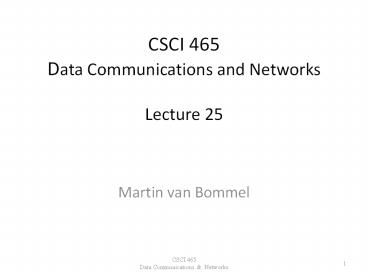CSCI 465 Data Communications and Networks Lecture 25 - PowerPoint PPT Presentation
Title:
CSCI 465 Data Communications and Networks Lecture 25
Description:
CSCI 465 Data Communications and Networks Lecture 25 Martin van Bommel CSCI 465 Data Communications & Networks * – PowerPoint PPT presentation
Number of Views:112
Avg rating:3.0/5.0
Title: CSCI 465 Data Communications and Networks Lecture 25
1
CSCI 465Data Communications and
NetworksLecture 25
- Martin van Bommel
2
IP Versions
- IP v 1-3 defined and replaced
- IP v4 - current version
- IP v5 - streams protocol
- IP v6 - replacement for IP v4
- during development it was called IPng
- (IP Next Generation)
3
Why Change IP Versions?
- Address space exhaustion
- 2 level addressing (network and host) wastes
space - IP network addresses used even if not connected
- Growth of networks and the Internet
- extended use of TCP/IP e.g. TV, point-of-sale
- single address per host not flexible
- Requirements for new types of service
- address configuration
- Routing flexibility - traffic support
4
IPv6 Enhancements
- expanded 128 bit address space
- improved option mechanism
- most not examined by intermediate routes
- dynamic address assignment
- increased addressing flexibility
- unicast, anycast, and multicast
- support for resource allocation
- labeled packet flows
5
IPv6PDU(Packet) Structure
6
IPv6 Header
7
IP v6 Flow Label
- related sequence of packets - special handling
- identified by source and destination address
flow label - flow number generated randomly
- make sure not to reuse within lifetime of old
flow - router treats packets of flow the same
- treatment pre-negotiated with router(s)
8
IPv6 Addresses
- 128 bits long
- Assigned to interface
- Same interface may have multiple addresses
- Types of addresses
- Unicast single interface address
- Anycast one of a set of interface addresses
- Multicast all of a set of interface addresses
9
Hop-by-Hop Options
- must be examined by every router
- if unknown discard/forward handling is specified
- next header type of header that follows
- header extension length length of this header
- Options
- Jumbo payload
- IPv6 packet is longer than 65,535 octets
- Router alert
- Tells router(s) that packet contains router
control data
10
Fragmentation Header
- fragmentation only allowed at source
- no fragmentation at intermediate routers
- node must perform path discovery to find smallest
MTU (maximum transmission unit) of intermediate
networks - set source fragments to match MTU
- otherwise limit to 1280 octets
- minimum MTU must be supported by networks
11
Routing Header
- contains a list of one or more intermediate nodes
to be visited on the way to a packets
destination - Includes
- Next header identification, Header length,
Routing type - Segments left number of route segments left
- Type 0 routing IPv6 header has address of
router - Routing header contains list of router addresses
- Next destination address first on list
- Final destination address last on list
- Each router on path moves address to IPv6 header
and shortens list
12
IPv6 Extension Headers































